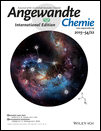Responsive Inverse Opal Hydrogels for the Sensing of Macromolecules†
Financial support from the German Federal Ministry of Education and Research (BMBF), initiative “Spitzenforschung & Innovation in den neuen Ländern”, cooperative project “Das Taschentuchlabor—Impulszentrum für Integrierte Bioanalyse”, FKZ 03IS2201 B/C.
Graphical Abstract
A successful marriage: The combination of smart hydrogels and inverse opal structures unites simplicity with efficacy for sensing macromolecules. While the inverse opal structure provides structural color and a large accessible interface for binding, the induced phase transition of the analyte-responsive hydrogel produces strong optical effects. The resulting spectral shifts can surpass 100 nm and are easily detected.
Abstract
Dual responsive inverse opal hydrogels were designed as autonomous sensor systems for (bio)macromolecules, exploiting the analyte-induced modulation of the opal’s structural color. The systems that are based on oligo(ethylene glycol) macromonomers additionally incorporate comonomers with various recognition units. They combine a coil-to-globule collapse transition of the LCST type with sensitivity of the transition temperature toward molecular recognition processes. This enables the specific detection of macromolecular analytes, such as glycopolymers and proteins, by simple optical methods. While the inverse opal structure assists the effective diffusion even of large analytes into the photonic crystal, the stimulus responsiveness gives rise to strong shifts of the optical Bragg peak of more than 100 nm upon analyte binding at a given temperature. The systems’ design provides a versatile platform for the development of easy-to-use, fast, and low-cost sensors for pathogens.





